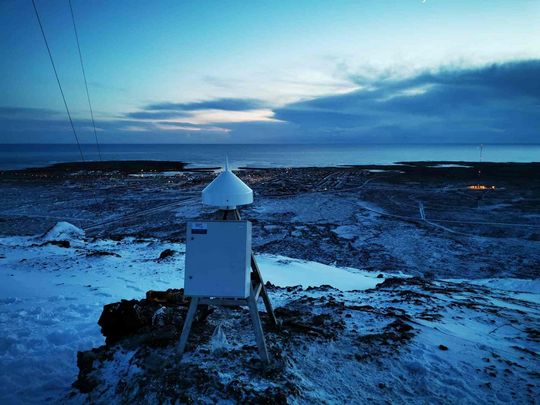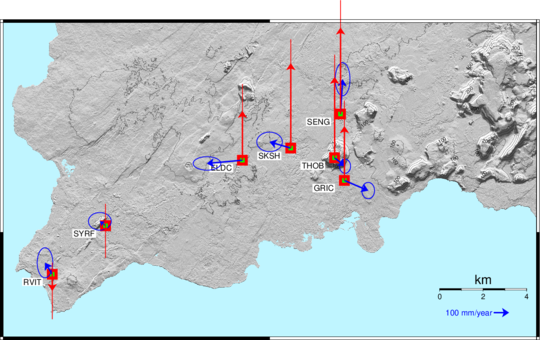New inflation and associated uplift detected at Mt. Thorbjorn volcano, Iceland

The latest results of deformation around Mt. Thorbjorn volcano on the Reykjanes peninsula indicate that inflation causing an uplift in the area has started again, the Icelandic Met Office reported on March 19, 2020. The uplift is slower than in January but seems to be in the same location. The most likely explanation for the signal is that inflow of magma started again, IMO said.
Meanwhile, earthquake swarm near Grindavik, just south of Mt. Thorbjorn, is ongoing. On March 19, IMO detected over 400 earthquakes in the area, with the strongest detected M3.3 and M3.2, some 3 km (1.8 miles) NW of Grindavik.
The uncertainty phase due to the uplift on Reykjanes is still valid according to the Department of Civil protection.
"From the most recent crustal deformation measurements, it is now clear that the inflation and associated uplift that occurred in Thorbjorn in January-February has started again. This is confirmed by both GPS and satellite data," IMO said, after a meeting held on March 18.
The deformation is occurring in the same location as before but at a slower rate. The uplift started in January and halted temporarily at the end of February. The most recent data show that since the beginning of March the uplift is about 20 mm (0.78 inches).
"The deformation now seems to be quite slow, slower than in January. Indeed, 20 mm is a small uplift and it is difficult to analyze such a small change. Data have to be collected for several days to confirm that an uplift is taking place," says Benedikt Gunnar Ófeigsson, a geophysicist at the Icelandic Met Office.
"We are now seeing signs of uplift and our calculations indicate that the source is similar to the source of the uplift in January," Benedikt said.
As was already stated by the Civil Protection Scientific Advisory Board, the most likely explanation for this deformation is magma accumulation at depth.
"Although we see the signs that uplift has started again, it does not mean that the events at Thorbjorn are accelerating, nor that an eruption will begin any time soon," Kristín Jónsdóttir, head of the Natural Hazard Monitoring Group at the Icelandic Met Office, said.
"It is known that magma accumulation can take place for a long time, months, even years, without resulting in a volcanic eruption," Jónsdóttir added.
"What we are seeing now in Reykjanes can last a long time and there can be a sequence of phases. The activity might reduce temporarily and slow down without coming to an end. The next steps are for the Scientific Advisory Board to meet to assess the situation. The meeting has been scheduled at the end of next week."

The image shows the average deformation velocity at the GPS stations around Þorbjörn and Reykjanesstá from March 3. 'THOB' in the center of the image shows the location of the station on top of Mt.Thorbjorn. The red arrows show the vertical displacement velocity, and the blue ones the horizontal velocity. The blue arrow at the bottom of the image indicates, as a reference, a velocity corresponding to 100 mm/year (3.93 inches/year) — that means approximately 1 mm / 0.04 inches per day. The figure shows that all stations around Þorbjörn are moving away from a common point. This pattern indicates that the magma is flowing upwards from depth and accumulating into the upper crust (at about 4 km / 2.5 miles depth). The vertical velocity shows that the crust has been rising of about 2 – 3 mm (0.08 – 0.13 per day). A similar trend is not observed at the stations farther away, like RVIT and SYRF. Image credit: IMO
An earthquake that was widely felt in the southwest of Iceland was recorded on the morning of March 12 at about 4 km (2.5 miles) NNA of Grindavík and 2 km (1.2 miles) east of the Blue Lagoon, followed by several aftershocks.
"We evaluated the earthquake on March 12 to be M5.2, but now we have reassessed its magnitude at M4.6," Kristín Jónsdóttir, head of the Natural Hazard Monitoring Group at the Icelandic Met Office, said March 19.
"It can be complicated to estimate the size of larger earthquakes, but now several of us have studied the event and this is the result. This is partly because of strong wave reflections in the crust in Reykjanes Peninsula that complicate the data processing.
Related articles:
IMO: Deadly gases measured, stay away from caves in Eldvörp area on the Reykjanes Peninsula, Iceland – February 21, 2020
The Icelandic Met Office (IMO) is warning residents and tourists to temporarily stop exploring caves in the Eldvörp area on the Reykjanes Peninsula due to deadly gasses measured in a cave close to a parking lot. In their warning issued at 10:59 UTC on February…
Decreased earthquake activity near Grindavik, magmatic intrusion just west of Mt. Thorbjorn, Iceland– February 11, 2020
Earthquake activity near Mt. Thorbjorn, Grindavik has decreased over the past 6 days, but small earthquakes are still being detected. Indications are that the crustal deformation pattern has changed, however, the uplift has slowed down. In total, the uplift is about…
Earthquake swarm, uplift west of Mt. Thorbjorn volcano continues, Iceland – February 01, 2020
Earthquake swarm and uplift west of Mt. Thorbjorn, Reykjanes Peninsula, Iceland continues on February 1, 2020. However, it is most likely that this activity will stop without any volcanism, the Icelandic Met Office (IMO) said. The last known eruption was during…
Unusually rapid inflation detected beneath Mt. Thorbjorn, Aviation Color Code raised to Yellow, Iceland – January 27, 2020
According to the Icelandic Met Office (IMO), unusually rapid inflation has been detected at Mt. Thorbjorn on the Reykjanes Peninsula over the past few days, indicating a possible magma accumulation. In addition, an earthquake swarm has been ongoing during the same…
Featured image: GPS station on Mt. Thorbjorn with Grindavik in the background. Credit: IMO

Commenting rules and guidelines
We value the thoughts and opinions of our readers and welcome healthy discussions on our website. In order to maintain a respectful and positive community, we ask that all commenters follow these rules:
We reserve the right to remove any comments that violate these rules. By commenting on our website, you agree to abide by these guidelines. Thank you for helping to create a positive and welcoming environment for all.